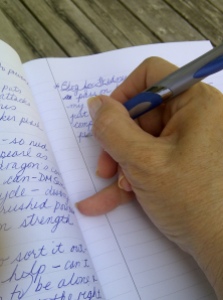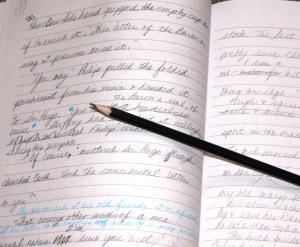
Whether you are participating in NaNoWriMo or not, there will be times when your current project loses its momentum and you need a new strategy to help you get your ideas moving and your words on the page. Below are some links to articles that will help you stay on track and achieve your goals.
For non-NaNo writers, my favourite strategy is to have more than one project on the go. When one gets stale or feels blocked, I switch to the other. While I’m working on the second project, the back of my brain will continue to worry away at the first one and the reason for the block is often revealed and solved.
When working on NaNo, you may find that you need to step back and revamp your outline. Once you got writing, your characters and plot may evolve beyond the planned events and backstory you started with. Sticking to you original concept can become hard and unsatisfying work. Consider taking an evening away from wordcount in order to take a good hard look at that outline and see where it should and could be going now that you are well into the story.
NaNo or not, make sure to drop by the NaNoWriMo site for encouraging and helpful writing tips and pep talks any time of the year. The resources for young writers and teens are perfect for helping writers of any age.
Also, here are a few articles I found that I think will help as you approach the challenging NaNo mid-point.
Okay, Hillary Retig’s article is nearly 10 years old, but check it out for “five strategies for making it past the dreaded ‘Week Two Doldrums’.” How to Get Past the NaNoWriMo Danger Point and Finish Your Novel is worth a read if you find your wordcount or will power diminishing.
Victoria Fry‘s article, How to Have a Proper NaNoWriMo Mentality, offers four great tips for keeping your brain from getting in the way of your creativity. “At the end of the day, what these mentality shifts come down to are this: NaNoWriMo is not just a numbers game. NaNoWriMo is whatever you craft it to be and, with a few clever tweaks, it might just turn out to be one of your favourite, most creatively inspired times of year.”
Check out Ingrid Sundberg’s article, NANOWRIMO: WHAT TO DO WHEN YOU HIT THE WALL, where she offers her “secrets to keeping the NaNoWriMo word count fires a-burning. One of my favourites: “Write the candy bar scenes first!”
Wishing you a writerly November!
CASL compliance: This message was sent to you by Heather Wright on behalf of Wrightingwords.com. If you do not wish to receive electronic messages from me or Wrightingwords, please reply by email and write “Unsubscribe” in the subject line. Unsubscribing will remove you from inclusion on any emails sent to you by me in the future, with the caveat that if you choose to opt out, then you will also lose all email correspondence for all Wrightingwords related news and activities.












